Well good morning everybody from beautiful Pearl Harbor, Hawaii. I bring you a greeting of a warm Aloha!
CHORUS: Aloha!
Alright, everybody obviously is a SUBPAC sailor at heart. Thank you again, John, for that kind introduction. Thank you to the Submarine League and to everybody here for the opportunity to talk to you a little bit and talk about things in the Pacific.
What I’m going to do just very briefly here, and certainly consistent with our theme for the symposium, is I’m going to take a little bit of time and describe the environment in which we’re operating along the lines of the Navy’s design for maintaining maritime superiority. Then I’m going to describe some of the things that we’re doing in that environment. But my major theme, the one takeaway with which I will start, finish and probably highlight in the middle, is actually something that has been voiced by some of my predecessors here on the podium. And that is, it is an incredibly important time to be a submariner. It’s also an incredibly exciting time to be a submariner.
I want to highlight here on the cover slide, on the top, the strategic mission. That, like Admiral Benedict briefed, that was the DASO D5 missile firing out of San Diego which was visible from Sausalito looking across the Golden Gate Bridge. That is not photo-shopped. That is what it actually looks like when you fire at dusk when the sun is illuminating the vapor trail and the sky is dark.
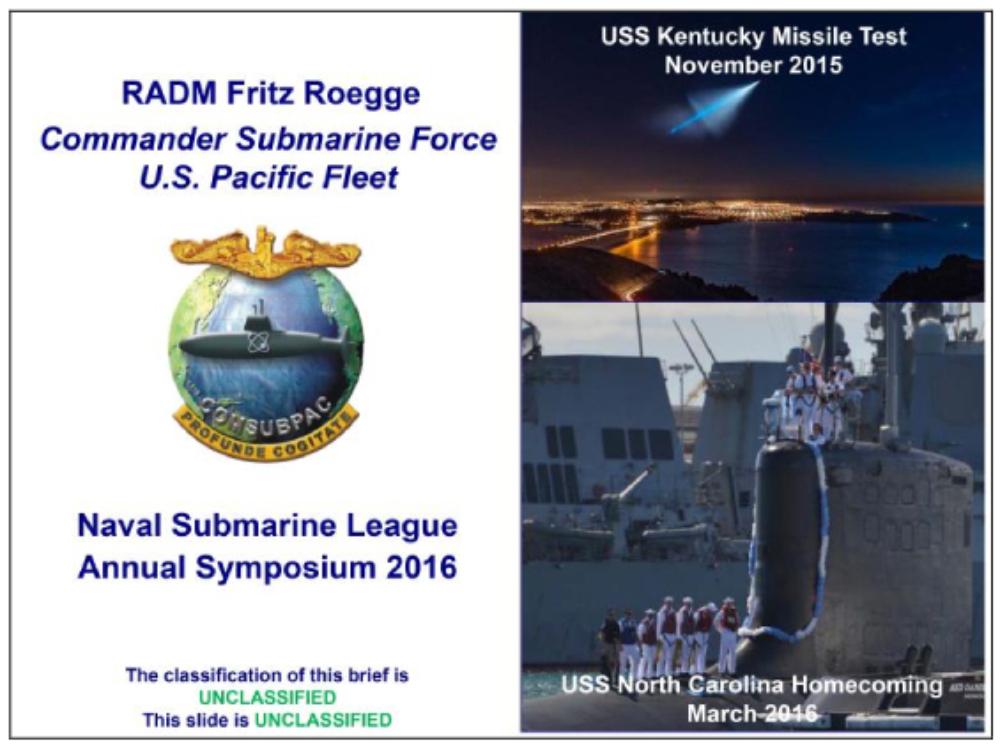
And then here, obviously, the return from deployment of one of our new Virginia-class submarines, the North Carolina.
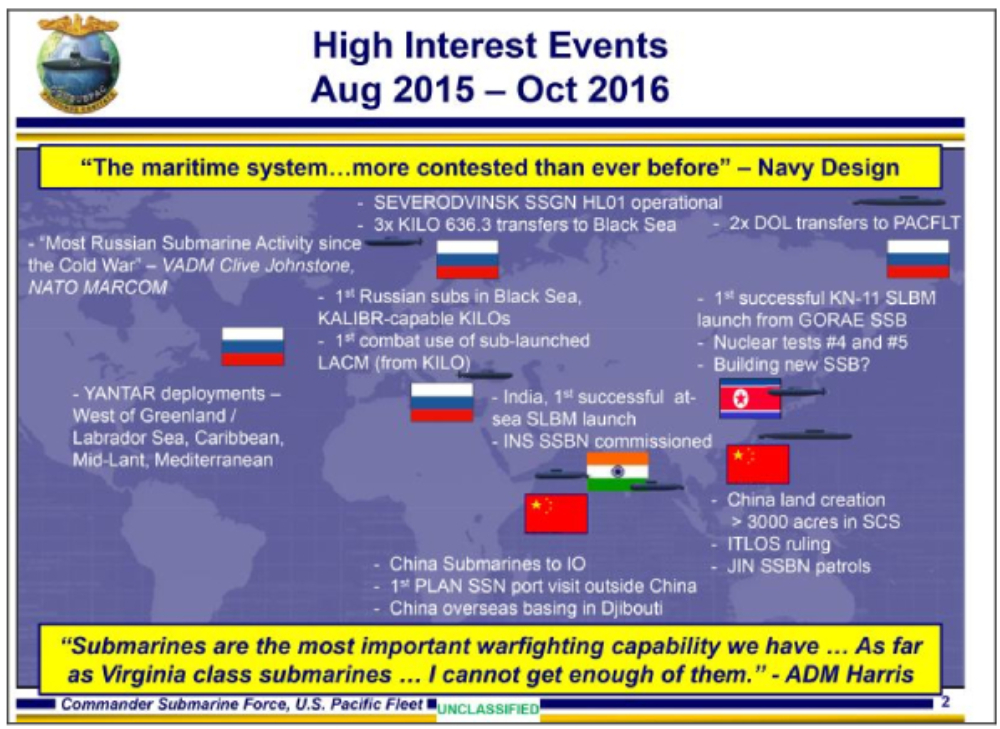
Admiral Tofalo already gave kind of a run down of some of the high interest activities. Some of the things in particular to the Pacific I want to emphasize here from the slide. The first is the fact that in addition to—in the middle there you can see a discussion of the Indian navy activity. In addition to the fact that they have just recently had a first successful launch of a ballistic missile, they have commissioned a ballistic missile submarine.
When we look over on the east side of the world, as in the slide there, we’ve already discussed the fact that recently North Korea test fired a ballistic missile. That calls into question, at what point will they then also deliver an actual, operational ballistic missile submarine? I have no doubt that that would be consistent with their intentions.
I’d also point out on here that the high interest operations is not only what’s going on beneath the surface. High interest operations include things like the fact that this last year in January the government of China concluded an agreement with the Djiboutian government. At the end of a two-year period in which they’ve invested about $14 billion in infrastructure and improve-ment products in Djibouti, they now have the authority to build a port that will be able to serve as a host for PLA vessels.
Similarly, it’s probably worth pointing out that on the other side of the ocean and of this line, is that just recently, a month or two ago, the International Tribunal on the Law of the Sea, rendered a ruling on a request from the government of the Philippines with respect to South China Sea territorial claims. What constitutes a land mass which can generate an exclusive economic zone, et cetera? Interestingly, although there are many, many territorial disputes which I’ll talk about more later, the Philippines is the only government that had gone to the Interna- tional Tribunal, which largely ruled in its favor. So a lot of very interesting things going on in the world.
Of course, on the yellow banners there you’ll see the top one comes from the Navy design. But I really want to call your attention to the bottom one, which is my Pacific Command Commander in his testimony to the Congress last year. For everybody in this crowd, and by that I mean of course it is self- evident, what could possibly be interesting and noteworthy about that?
Well what’s interesting and noteworthy about that from my perspective as the senior submariner in the Pacific is I’ve got many, many bosses. But particularly within my theater, when I go to the 3rd Fleet Commander, Vice Admiral Nora Tyson, the 7th Fleet Commander, Vice Admiral Joe Aucoin, the Pacific Fleet Commander, Admiral Scott Swift, the Pacific Command Commander, Admiral Harry Harris, and as of next week the new Strategic Command Commander, General John Hyten, I’ve got four naval aviators and one Air Force general officer, and those aviators all telling me that they love the Submarine Force and wish they had a lot more. So that’s what makes that particularly noteworthy.
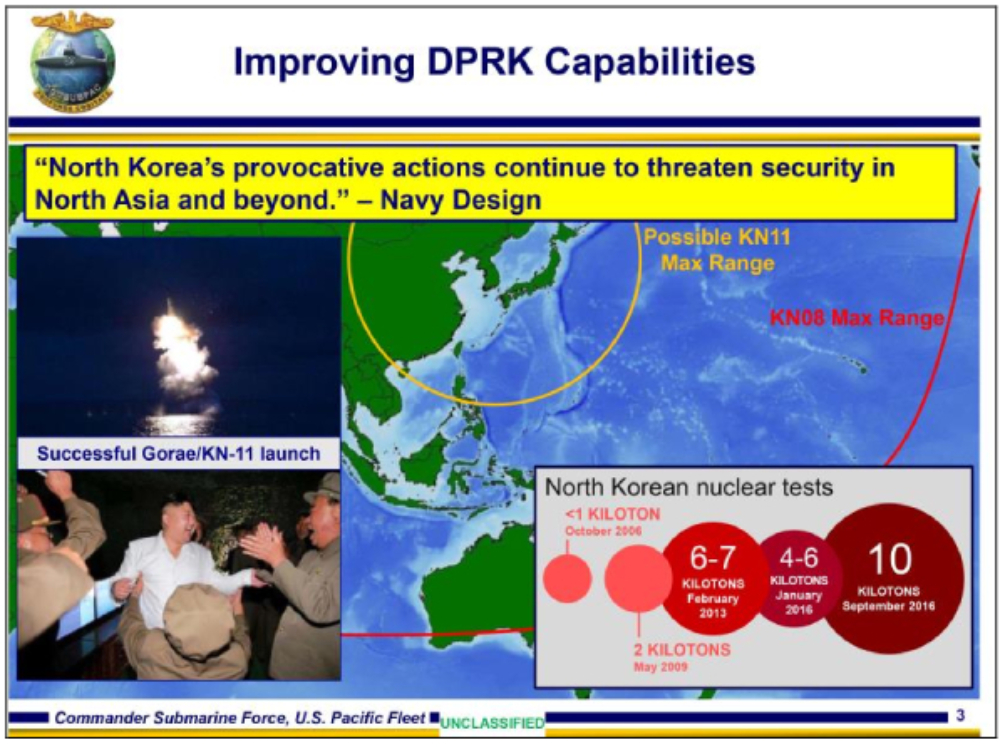
I’ll just kind of walk around the theater briefly again. We’ve talked already at length on some of North Korea’s recent activity. Again, the design calls out provocative actions. And almost as if on cue, they’ve unveiled just within this last year, since the publication of the design, two more nuclear tests. As you see in that CNN graphic in the lower right, ever increasing in size or estimated power, and of course now increasing in the frequency of testing.
So as one of the previous speakers mentioned, two tests in a single year, that’s also unusual. For comparison purposes, the World War II nuclear events, Hiroshima and Nagasaki were a little bit larger but the same order of magnitude. Those were about 15 and 20 kilotons apiece. Admiral Harris in his testimony made it very clear that his assertion or his estimate is that North Korea is on a quest to not only develop this capability but to be able to miniaturize it, weaponize it, and to be able to try and defend their perceived security interests by being able to hold regional potential adversaries at risk.
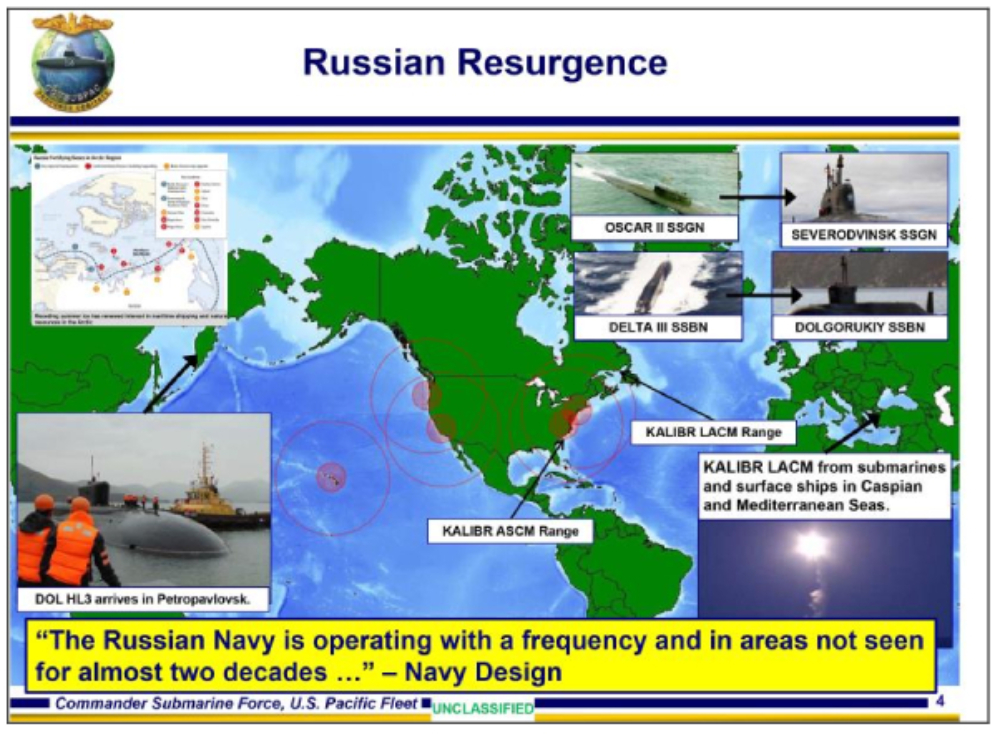
Also we’ve talked a little bit about some of the activities in the Russian navy. In the upper right there, the purpose of those four pictures is just to kind of show that the significant investments that have gone on over the last five years, halfway through this decade, have resulted in a lot of modernization, a lot of new capabilities and a lot of new modernization. So although in overall order of battle the Russian navy is, like our navy, isn’t larger, it’s actually smaller than it was in the Cold War. The capability is much improved through modernization, as you see going from Oscar II SSGNs to Severodvinsk in the ballistic missile side; from Deltas to Dolgorukiy, which we now have out in the Pacific.
Over the last five years, really over the last decade, Russian military spending has roughly doubled; and that despite some pretty significant economic sanctions, that despite negative economic growth over the last few years as a result. It clearly is a national priority and they are doing what nations do. They’re investing where they see their national priorities.
A couple of other things I want to point out on this slide. In the upper left, it’s a little hard to read, the details aren’t specific, but that is a little picture of the Arctic with the northern Russian coastline at the bottom of the picture. What that is, is identifying all the investment going into resurrecting Arctic capability along the northern military district bordering the Kara Sea, the Arctic Sea, et cetera, Arctic Ocean, et cetera. So there’s a lot of Cold War bases that had been shut down now being reactivated; again, investments in capabilities and repositioning of forces.
Now again, with the potential that there could be greater access to the Arctic for commercial traffic, that could be as simple and humanitarian as the desire to be able to be better postured to render aid and assistance to stranded mariners. I won’t surmise, maybe any motives, but the capability is certainly being put into place there. And the Arctic, of course, is one of those areas of the world that as it becomes more accessible it does have resources and will probably become an area where there’s going to be competition among nations.
In the lower right is just a picture of a cruise missile in this case being fired from a surface ship. Ever since 1991, and for the last 25 years, that picture would have had to have come from a
U.S. warship or a Royal Navy warship. I mean, we’re the only nations that had precision guided munitions and have actually fired them in time of conflict. That changed within the last couple of years as the Russians have deployed their Kalibr missile system and have employed it in some of their current ongoing conflicts, including having been launched from a Kilo diesel powered submarine into the Middle East, into Syria.
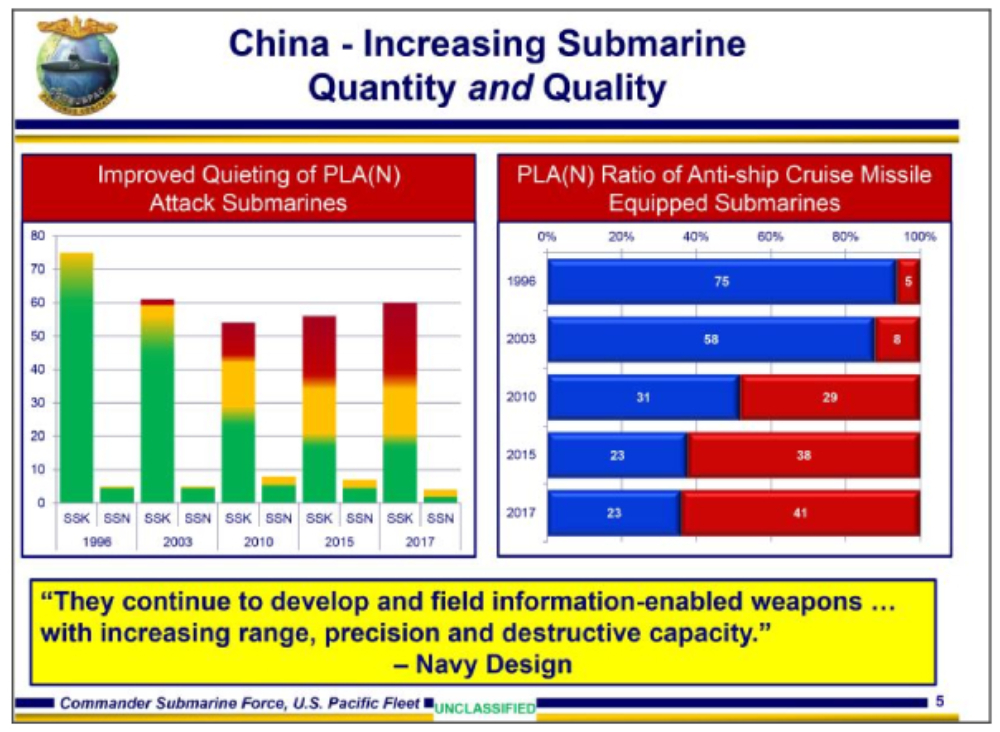
To talk about China now for a moment, again the specific numbers here are less important than just kind of the trend. On the left here what you see is improved capability, and I’m just drawing the broad kind of conclusion that as you modernize and develop capability, you know, boats are getting more quiet. What you see there is, there’s no legend on the slide, but basically you can see the older classes of submarines, and the newer, modernized, and more capable submarines.
So you can see the trend, both on the conventional powered SSKs as well as SSNs, but the trend is that they’re investing in improving their capabilities. On the right hand side, what you see is, of those submarines, what is the ratio of boats that are capable of going to sea carrying anti-ship cruise missiles? And then not explicit on the slide, but I hope implicit from my remarks, is that as they invest in capabilities it’s not only the number of platforms capable of employing anti-ship cruise missiles, but the capability of those missiles continues to improve.
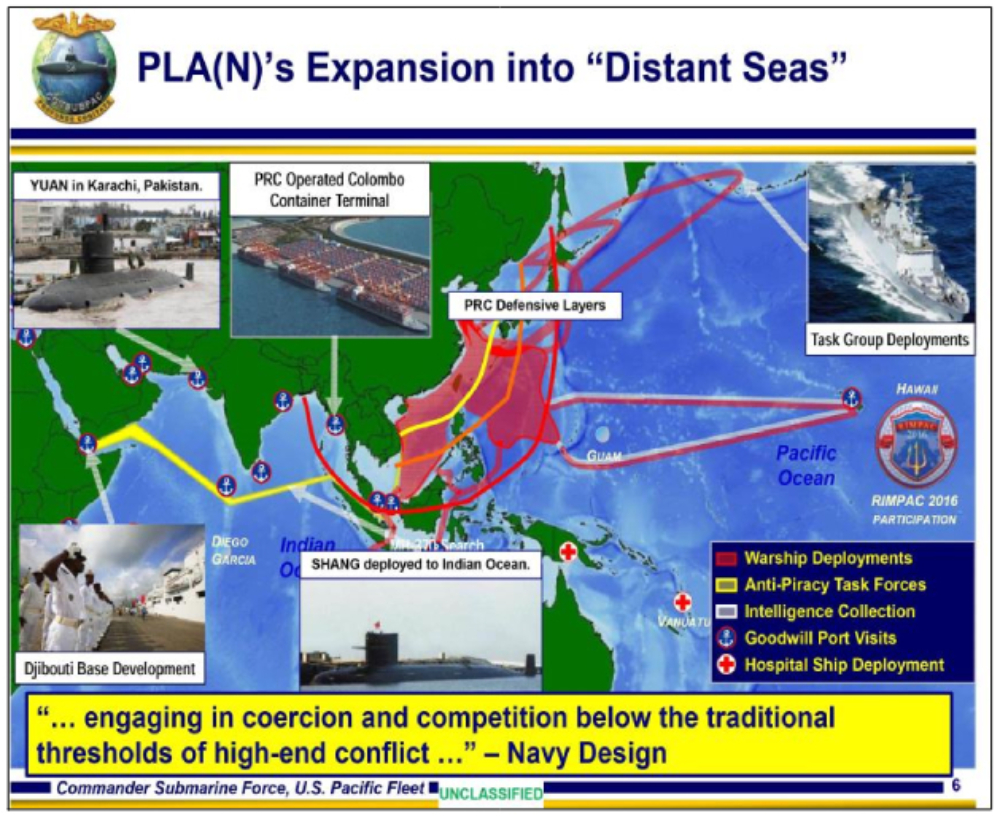
Operationally, there’s a lot on here. It’s a little bit dense, so give me a moment to kind of walk you through this. This is going to be a challenge. I’ll both gesture and stay close to the mic, so forgive me if I wander off here.
First off, kind of with respect to a PRC or PLA view of the world, we’ve all heard discussion of things that matter to the Chinese, the first island chain, the second island chain. So as they’ve developed capabilities they have sought to be able to defend or protect their national security interests by ever expanding those defensive layers.
Although typically we think of the second island chain as being a Western Pacific sort of an arc, there is some literature that indicates as well that in the Chinese view that extends around into the Indian Ocean. Obviously if you reside in India, you have always extended historically to view the Indian Ocean as your own area of strategic interest. So that has the potential to raise some interesting conflict or certainly friction in the future.
So of the lines then have to do with some of the nature or specific trends in deployments and operations. What you see over here is that as China again has done what growing naval powers do, they are expanding their areas of operations. They are trying to test themselves and determine what their limitations are; identify then what the limiting factors are and try and address those.
So they’ve been operating more and more outside of the Western Pacific and moving to the India Ocean, a very Mahanian sort of perspective, coaling stations and all that. So they’re looking to provide the ability to sustain and provide support to naval forces along here. They recently concluded a commercial operating agreement with Sri Lanka for a container terminal in Colombo. They’ve had port visits in Karachi, Pakistan. As I mentioned earlier, $14 billion worth of investment in Djibouti and in return the right to establish a logistics presence there.
This is operation by surface ships and task forces, by diesel submarines and by nuclear powered submarines as well. Again, although there are certainly areas where there is competition with the PRC and the PLAN, we continue our engagement with them as well. Both in 2014 and now more recently in 2016, China was invited to participate in the Rim of the Pacific exercise.
So this last July and August we had five PLAN ships visiting Pearl Harbor in support of RIMPAC. And then interesting here, you know I mentioned the Arctic earlier. But of note here in 2015 there was also a Chinese task force deployment that went up for the first time into the Bering Sea. That, again, is completely consistent with how China has expressed their interest.
There is an Arctic Council of Arctic littoral nations. China is not an Arctic littoral nation however they have requested observer status because they have declared themselves to be a near-Arctic nation. That’s an undefined term. I don’t know exactly what that means, but it matters to them so I thought I’d share it with you.
Also in 2015 there was an expeditionary task force that con- cluded an around the world cruise as well. It left the Indian Ocean through the Med, circled up to port visits in Scandinavia, over to the U.S., Panama Canal, and back across again. So again, they’re doing what growing navies do.
And that also includes arms and weapons sales. Their Yuan- class SSK, their latest conventional AFE submarine, they’ve announced deals to sell those to Pakistan and to Thailand. In fact, this is an area where there is a lot of nations now that operate submarines.
Last year when I was briefing I pointed out that, perhaps surprisingly, a lot of those nations, apart from submarines, are not only buying something from overseas but they’re investing in the capability to indigenously produce their own submarines. So it’s not only this crowd that recognizes the values of the undersea domain and of submarines.
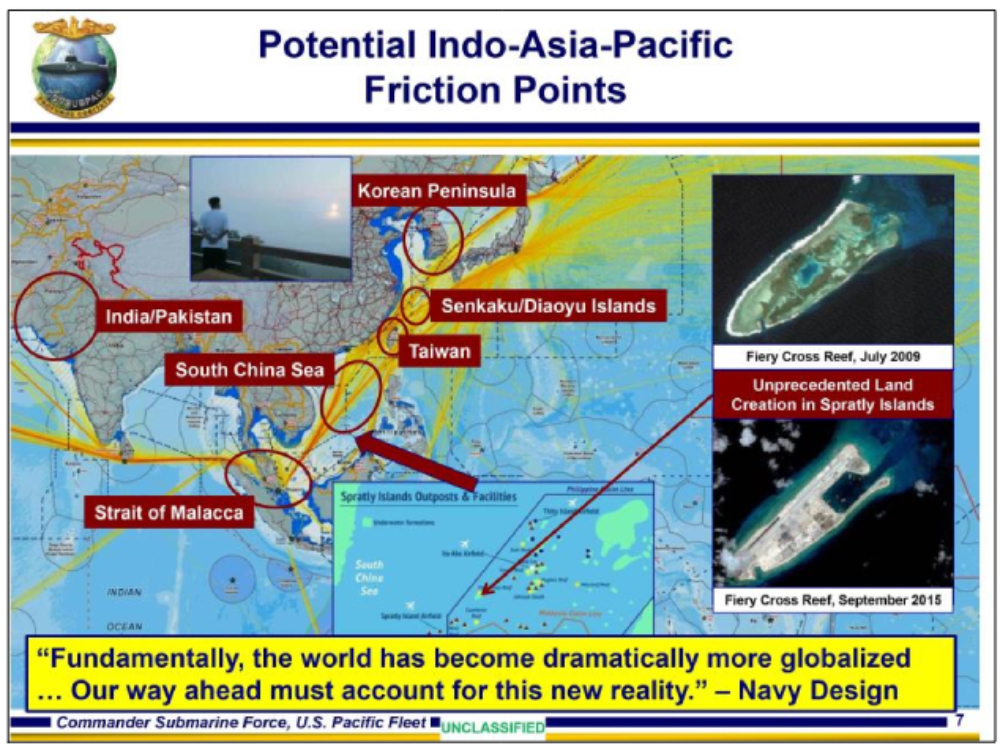
I mentioned the competition, possible sources of friction. This is a graphic that helps me to tell that story. This shows the increase in intensity, which has to do with density of shipping as tracked through AIS, the Automated Identification System used in the commercial maritime environment.
So again, it’s no surprise to this crowd, but these are vital shipping lanes. Twenty-five percent of all traded goods and 25 percent of all oil goes through the Strait of Malacca. Most of that, as well, continues through the South China Sea. That means that when there are sources of friction, that should be of concern to us as naval professionals.
Obviously, America has always been a maritime nation. Our prosperity, and consequently our security, rides on trade across the oceans and the freedom of the seas that enable that. Of course, as a naval officer, I have to note again that even our founding fathers recognized that in the Constitution, because that’s where it’s recorded that the Congress has the power to raise armies as needed, but the responsibility to maintain a Navy. So I would roll that out on Army-Navy Day.
And of course for the last 15 years our focus has been ground combat in the Middle East. But now that that is winding down, our focus has shifted and, of course, concurrent with that was the end of the Cold War. But now we do see that there’s nations that are aggressively seeking to expand their influence, building military capabilities, and that competition among nations often plays out first in competition on the high seas.
Therefore, the focus of U.S. military activity for the next 15 years is likely to be at sea. So this is a maritime decade, unques- tionably I think, but more importantly I think this is preponderant- ly going to be a submarine decade. As a potential adversary develops those capabilities that are specifically designed to thwart the U.S., there’s no question it increases the risk to surface ships, to aircraft. But fortunately, thanks to all your good work, the Submarine Force retains the unique ability to go undetected anywhere in the world and to hold at-risk the things that potential adversaries hold most dear.
Our submarines are able to do that, of course, because they are the best submarines in the world, again thanks to all of you, but most importantly because they’re operated by the world’s most capable submariners, the most capable crews. So that remains our secret sauce. Bill Merz already kind of alluded to that before. On the scale of technology there’s always going to be competition, there’s always going to be step improvements. I don’t foresee a future in which our technological advantages are ever surpassed, but I’m very confident that our people’s core competency is never going to be surpassed.
I just wanted to point out as well here that this competition here, the competing territorial claims, all these littoral nations are a part of that. There’s any number of—well, seven different nations around here that have claims that conflict with each other. Similarly, down here in the Spratley’s, there’s 71 different outposts on different little outcroppings of rock, again from the seven different nations.
So although I think these examples here like Fiery Cross, are probably the most extreme examples of trying to enhance territorial claims. It’s not only China, but again, it’s probably the most dramatic. And, of course, one of the things I really want to emphasize here is that sometimes this activity is referred to as land reclamation. I don’t think there’s any legal or moral sense where you could say that that is an accurate characterization.
There was never any land there to reclaim. This is reef de- struction for the purpose of land creation, all for the purpose of enhancing territorial claims.
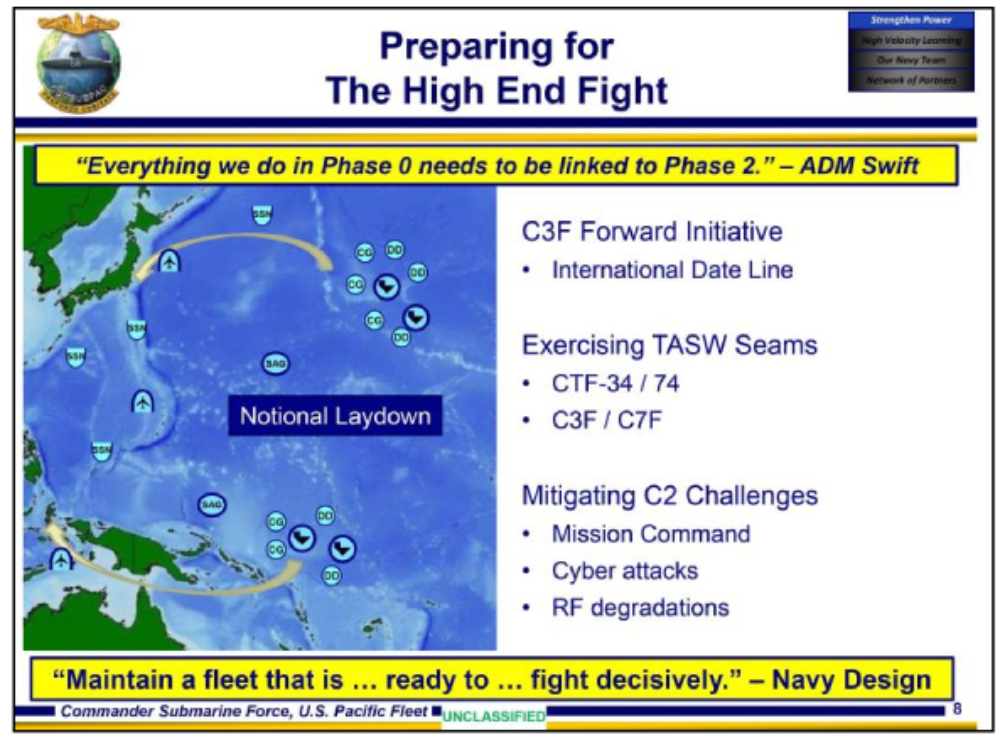
But that again was kind of the walk around the environment. What are we doing in that environment? Well, Admiral Swift has been my Pacific Fleet Commander boss. He has been very consistent in reminding all of us that in these days of competing demands and limited resources, we’ve got to be very sure that we’re very efficient in what we do.
So everything that we’re doing in phase zero peacetime opera- tion, ought to be able to tie directly to the developing skills, competencies, deterrence, credibility, things that can be linked to phase two. So one of the things on the right hand side here is some of those things that we are doing to prepare for the high-end fight should, God forbid, that become necessary. So make no mistake, if we are very, very effective at phase zero at demonstrating our capability and having the credibility of our ability to employ those forces, we’ll never get to phase two. I’m very confident of that.
But part of making sure that deterrence is effective is always being ready. So 3rd Fleet forward, Admiral Swift has talked a lot about this. It’s really nothing new. I mean, this is how World War
II was fought. We had multiple numbered fleets all operating forward under their own OPCON, and that’s something that—and of course we’ve always had ships from the 3rd Fleet that are generated before deployment, and are manned, trained and equipped in kind of a fashion that then goes forward and operate forward under 7th Fleet OPCON.
What’s different here is operating in the 3rd Fleet OPCON. Of course it seems kind of intuitively obviously. If I’m the Pacific fleet commander and I’ve got all these ships, if I ever need to do anything, achieve some objective, why wouldn’t I use all the ships? So it’s interesting that somehow it seems to be character- ized with great surprise and really innovative. Of course, I tell my boss he’s really innovative, but again it’s just the way we’ve always kind of operated.
Additionally, Admiral Merz really highlighted from his time at CTF-74, the great partnership that we had. So I do not only the force generation, but I’m also CTF-34 for theater ASW. And one of the things that we are doing more of now is making sure that when we do our own kind of training event and exercises, it’s very easy to generate an exercise that has somebody come down and evaluate my theater staff’s ability to do our job, but that’s now how a fight would actually be fought. A real fight would be fought, again, with multiple demands and competing resources, and so we’ll have to be sure that we are exercising our ability to manage those competing demands.
The DDG that Bill mentioned was great fun when he had Administrative Command (ADCON) in order to employ for ASW, but maybe a DDG may be desired by the air and missile defense coordinator to provide BMD support or something. So he can’t really stream his tail at that time, so how are we going to deal with those kinds of stresses? So we’re exercising across those seams.
And then, of course, we anticipate that there’s always going to be the potential to have to overcome challenges to our command and control. Obviously mission command-type orders is, again, how we fought World War II, I think with some level of success. But, of course, now with cyber attacks we need to be sure that we are prepared to defend against and work through, as well as things in the rest of the electromagnetic spectrum.
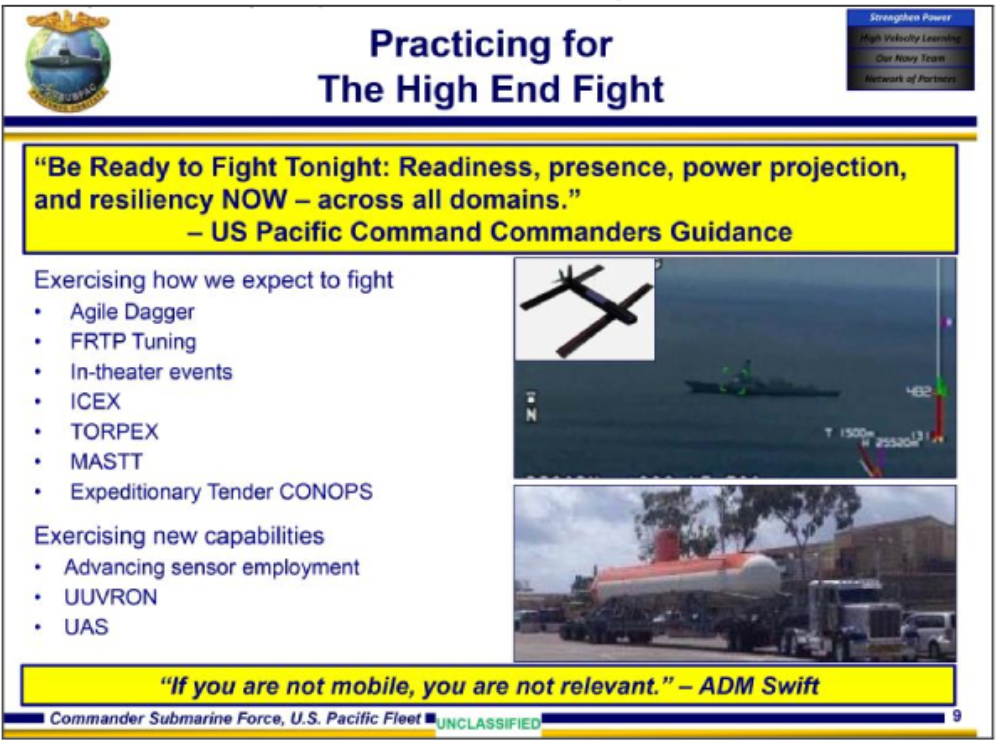
So part of being prepared, again, is making sure that we’re exercising how we expect to fight. Agile Dagger is an exercise that is self-generated—initiated with some backup as our partners. We take each of our various old plans, and we make sure that on any given day we know exactly how we would resource them, ship by ship, hull by hull, where are the torpedoes coming from, and our ability to meet the timelines expected by the commanders.
Admiral Tofalo mentioned Fleet Readiness Training Plan (FRTP) tuning. This is an effort to make sure that we are squeezing out of the inter-deployment training cycle, all of the discretionary time that we can in order to develop our war fighting skills, whether it’s having our own boats in theater locally working against each other for the purpose of improving their anti- submarine warfare skills, whether it’s dedicating them to tactical development. But generating more free time gives us as operation- al commanders a greater ability to demonstrate our readiness for phase two. And that’s not only local waters, on the force generation.
Well, FRTP is on the force generation side, but Admiral Merz again as CTF-74, and did great things in taking the boats that I had sent him forward, while forward deployed, and doing in-theater events. Again, it has the extra benefit then of making sure that those commanding officers, those crews, are practicing those skills in the environment in which they might be called upon to use them. It’s a big ocean. From the surface, an ocean looks like an ocean. But the thermocline, the bathymetry, in the Eastern or Central Pacific around me where I’m doing my work, is very different than a lot of the places where Admiral Merz was employing forces, a lot more in-theater events.
ICEX, as we mentioned, again, the ICE is one of those envi- ronments that we’ve called home for years. ICEX 2016 I had the opportunity to go up and visit. Incredible, impressive level of effort in just making sure that we’re always generating proficiency and comfort operating up there. Again, as we mentioned, it could be key to how we operate our forces in times of increasing tensions.
We do TORPEXs in theater, just like we operate some kinds of things in theater. MASTT, that’s the picture in the lower right, that’s a mobile ASW training target, 80-foot long, autonomous.
We can have it bottomed and determine the effectiveness of our sensors being able to detect. So it’s a great capability coming online.
And then as you see in the banner at the bottom, part of oper- ating in this theater—and particularly as potential adversaries develop capabilities with ever great reach—part of our plan for success is to ensure mobility, the ability to avoid being threatened or targeted by not being there. So if you’re not mobile, you’re not relevant, and that’s certainly how we’re approaching things. We recently brought the submarine tender Emory S. Land back from Diego Garcia, home ported in Guam.
So now we have a concept of operations that basically has one of those two tenders always out and about and certainly providing logistics supports to submarines as well as surface ships. It’s a tremendous engagement tool. We recently were doing an engagement with a Southeast Asian partner and they were very reluctant to be seen having a U.S. submarine in port, but having a U.S. submarine tender in port, that wasn’t an issue. So that’s probably a good first step.
And then new capabilities, sensor employment, we’re always developing, working on improving our tactics, our techniques and our procedures. Again, something that was mentioned a little bit earlier, as the predominance of our force slowly shifts from Los Angeles-class to Virginia-class, I believe that there’s more we can wring out of the tremendous capabilities of the Virginia-class. I think that in many cases we’re still driving Virginia’s the way we drove the 688s because that’s kind of how we all grew up, and I think that there’s more that we can do. That’s a challenge that formerly Admiral Trussler, now Admiral Jimmy Pitts at the Undersea Warfare Center has embraced.
We talked a lot about unmanned vehicles. This year we’re creating a UUV, unmanned underwater vehicle, squadron, subordinate to DEVRON 5 up in Bangor, to provide more focused support. And Admiral Merz has mentioned unmanned aerial systems. In the upper right there you see one such system.
That is kind of like Admiral Tofalo mentioned yesterday with some of the Remus vehicles in the unmanned underwater environment. This is something that went very quickly from a capability that we discovered to being tested for operation in the submarine environment. And it’s now something that I have on deployment today going forward that we are going to find ways to use.
This is a little three-inch device that gets shot out of a single ejector. You can control it with a kit on a joy stick from the submarine. It’s pretty amazing. And of course, we’ve got a generation of young submariners who are just fighting for the change to have that joystick, because that’s an environment they’re very, very comfortable with.
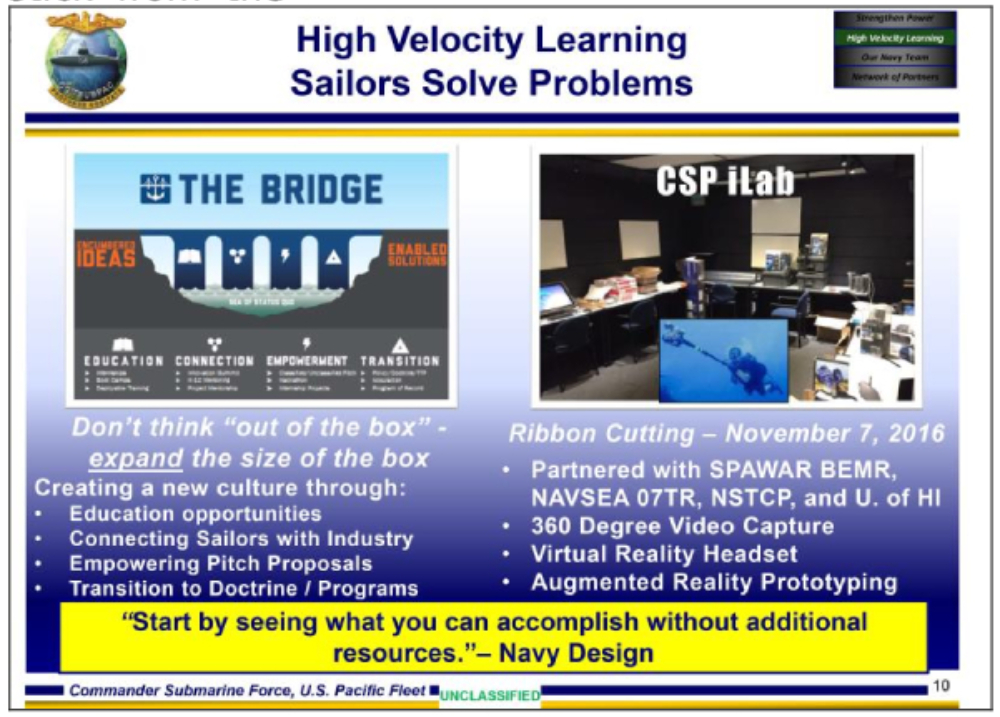
On high velocity learning, this has been talked about a lot. I just want to highlight a couple of specific initiatives. The bridge is really on approach. It’s a venue, a marketplace almost for ideas. But Admiral Swift has been very proactive in reaching out to the waterfront in recognizing that the good ideas don’t get generated by headquarters. The good ideas get generated by sailors on the deck plate. So he’s provided a venue for those ideas to be brought forward, and it’s working very well.
On the right side, out at SUBPAC we’re creating our own innovation laboratory. We’re looking to have a ribbon cutting here as soon as I return from my current around the world travels. We found a room up at the Naval Submarine Support, Naval Submarine Training Center Pacific (NSTC-P). That’s a great place because every submariner goes through an NSTC-P at a pretty regular drumbeat. Put it right by the front door, and basically we’re creating a MakerSpace.
So we’ve got some VR technologies, some AR technologies, and what you see there in the little inset picture right here. So this is an application lab. This is something that was done with the SEALS for the training of operators for operating with dry deck shelters on submarines. Basically for a $10,000 Oculus Rift or equivalent kind of capability, we had some divers go down, film themselves with a bunch of GoPros, and now you can put on the headset and without ever having to get into the water or get into a wetsuit, you can train your SEALS on the skills required to land that little SEV in the DVS, and with huge efficiencies, increase the number of reps much, much to reduce training times.
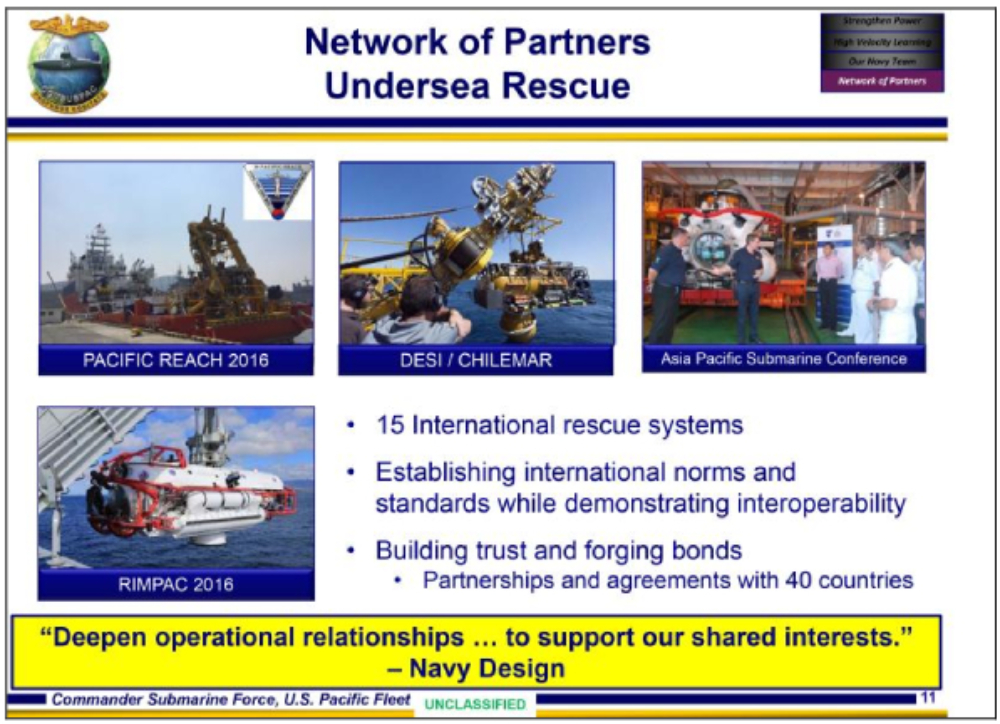
Partners. Speaking of partners, I’m delighted to see so many of our international partners in the room today. Again, as Admiral Tofalo made clear, in our own commander’s intent, certainly the CNO highlights it in the Navy’s design, we are better for our combined strength. So again, I appreciate seeing all of our partners here.
The way that we’ve organized in the Submarine Force is at SUBPAC I’m also the lead type commander for the Navy’s submarine escape and rescue capability. Submarine escape and rescue turns out to be a great—I mean, it’s certainly an important skill. It’s one as a submariner I hope to never have to call upon.
But it’s a great engagement tool. Regardless of what other areas of naval activity there may be competition, how can any reasonable nation not agree that it would be good to have interoperability in submarine rescue? And so just within the last year you see several examples of this.
We had Pacific Reach in 2016, an event hosted by the South Korean navy and participated in with the Japanese, the Australi- ans, and a Malaysian support vessel. In the middle there, the DESI, the Diesel Electric Submarine Initiative, Admiral Tofalo mentioned. We have a Chilean submarine, the Thomson, up in San Diego right now. We did a submarine rescue event on the Thomson out of San Diego.
There’s the Asia Pacific Submarine Conference annual con- ference, initiated by the U.S. Submarine Force, but now embraced by the international community who kind of takes turns hosting things. Twenty-seven nations all participating to discuss how we’re going to better cooperate. And even the RIMPAC 2016 this last year, for the first time we had a submarine escape and rescue event. This was one that was done with a multi-national table top exercise. Then, for the first time ever, we did a specific event that allowed the PLAN to demonstrate the ability to use their rescue vehicle to mate up to a NATO sized training device that we had parked south of Oahu.

Partners also include a lot of training that we provide at SUBPAC. You can see here some examples. Japanese, Australian, Korean, Singapore, are among those taking advantage of the facilities at NAVSEAPAC. A fire control center, attack center training, sonar and oceanography kind of classes. We get certainly great engagement, but we also get greater interoperability by better understanding each other’s capabilities.
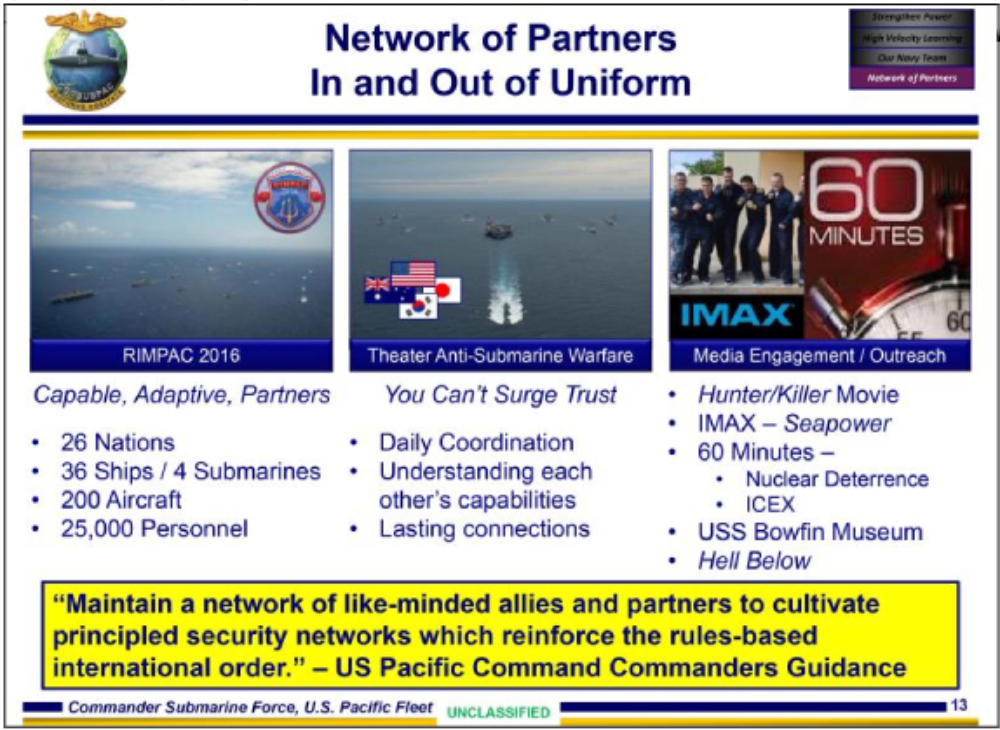
And then that partnership includes certainly RIMPAC. We’ve talked about, theater ASW, which Bill Merz has already covered. In the interest of time I won’t expand anymore.
But it also includes our outreach. Over there on the right side, this is going to be a pretty public year for the Submarine Force. Last night there was an event at which CNO Richardson addressed a smaller group. One of the folks that was recognized last night was George Wallace.
I don’t know if George is in the room right now, but he’s a former submarine commanding officer and now published author. But add to his resume right now a screenwriter because one of his books is being turned into a movie called “Hunter-Killer” which is filming on Oahu next week. The second unit is filming, not the stars.
This right here is my new good friend Jerry Butler. Gerard Butler is right there coming out of the wet trainer as part of his orientation there in Pearl Harbor. “60 Minutes” has just recently had something on the nation’s nuclear deterrent. I hope everybody saw that. I thought it was a piece that was well done and did a good job of explaining the importance of the strategic mission.
IMAX was out filming something for something that’s going to be in theaters next year on sea power. Hopefully some of you as well have seen the Smithsonian series Hell Below on the World War II experience. And then I want to call out the Bowfin as well.
I know Chuck Merkel was here. Chuck, I know, was here yesterday. Chuck now runs the Bowfin out in Pearl Harbor.
One of the things that’s pretty unique about—and this is my getting off the stage splice, so don’t worry I’m wrapping up—but one of the things that’s really kind of unique about being at Pearl Harbor is I can sit in my house and look out over the harbor and with one scan of the horizon I can see very visceral reminders of the start of World War II, in the Arizona Memorial; the end of World War II, in the USS MISSOURI where the peace treaty was signed; and of course all the reasons why we eventually won World War II. I can look over the shipyard and recognize the dry docks that were struck. Six of those eight battleships that were sunk returned to fight in the war thanks to the naval shipyards.
I can look over and see the fuel farms and recognize it because they weren’t struck. Four billion barrels of oil were able to power the fleet as it went forward on December 8th. And of course I can see the submarine base.
Of course, we as submariners all know that period of World War II, certainly a period of some of our greatest successes, generated some of our greatest heroes, also our greatest sacrifices. But the fact that the submarines and the submarine base wasn’t struck meant that on December 8th submarines could start flowing forward with the results that we’re all aware of.
Anyway, that’s a long segue to explain my bullet here. The most popular tourist attraction in Pearl Harbor is the USS ARIZONA and the visitors center there. It’s a great little museum at the Arizona visitors center, but you can go anywhere around Pearl Harbor and not find a single mention in any of the public tourist information displays about that proud history of the U.S. Submarine Force.
So thanks to a good partnership between my staff, on or about December 7th of this year, the 75th anniversary, we’re going to put a large information display up down there at the —you know, the BOWFIN shares the site with the ARIZONA Memorial, so the BOWFIN will host it but it will be available for the tourists of the ARIZONA. That highlights those significant contributions of the U.S. Navy in a way that currently is not captured anywhere. So I’m very excited about that and very pleased with the partnership with the BOWFIN.
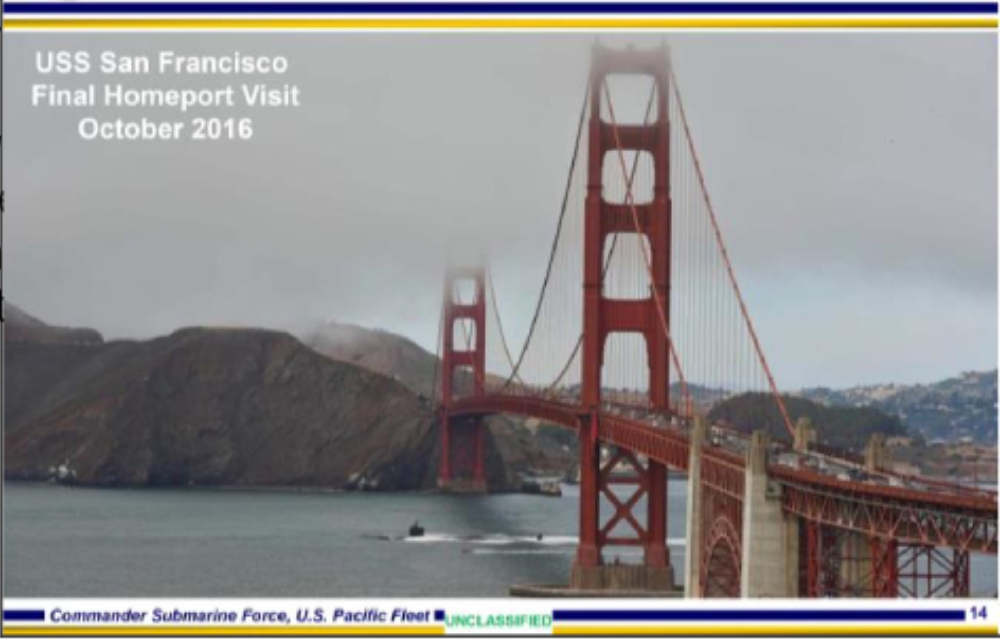
With that, what you see here is the final home port visit for the USS SAN FRANCISCO as she heads off to her inactivation. Again, in closing, to all of you here, men and women of the Submarine Force, all the organizations here that support our submarines, let me just again close by reminding you that this is an incredibly important time for our Submarine Force, and also an incredibly exciting time. What you all do every day, what our force does every day, makes a huge difference to the Navy, to the nation, and to our allies across the world.

